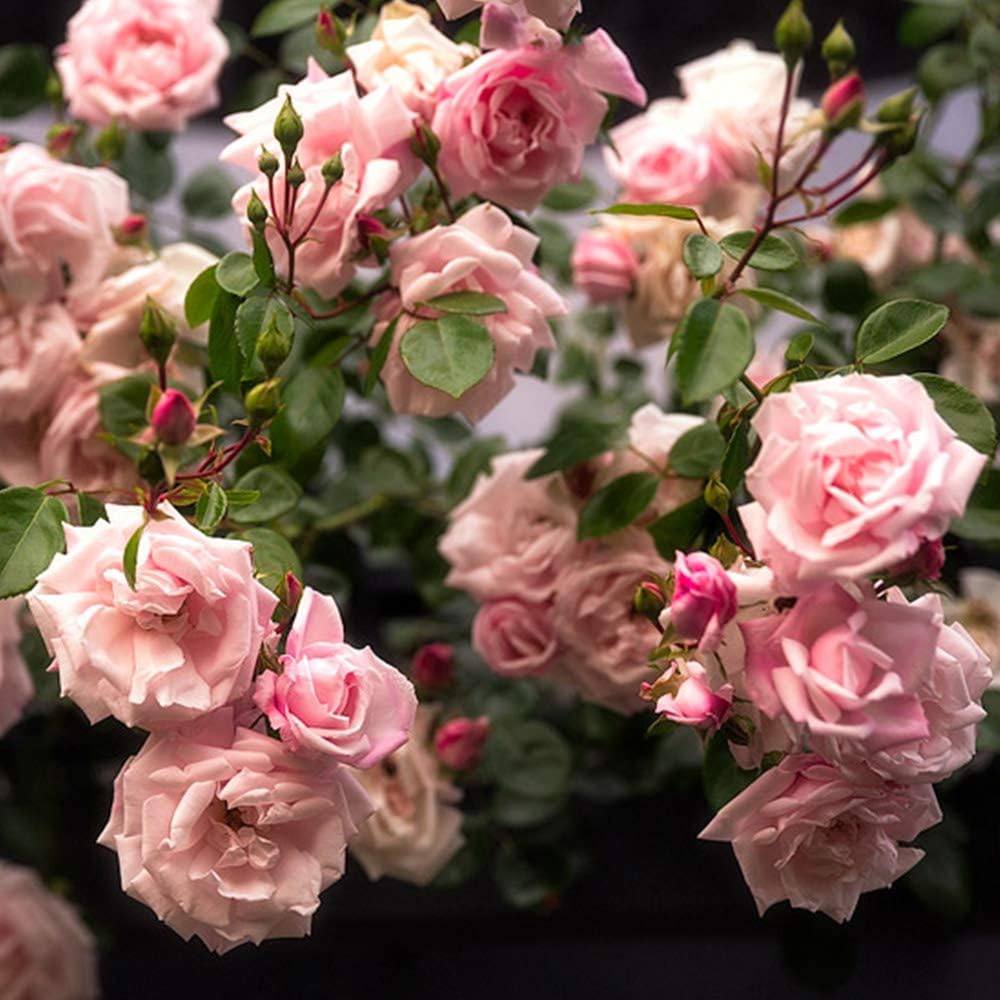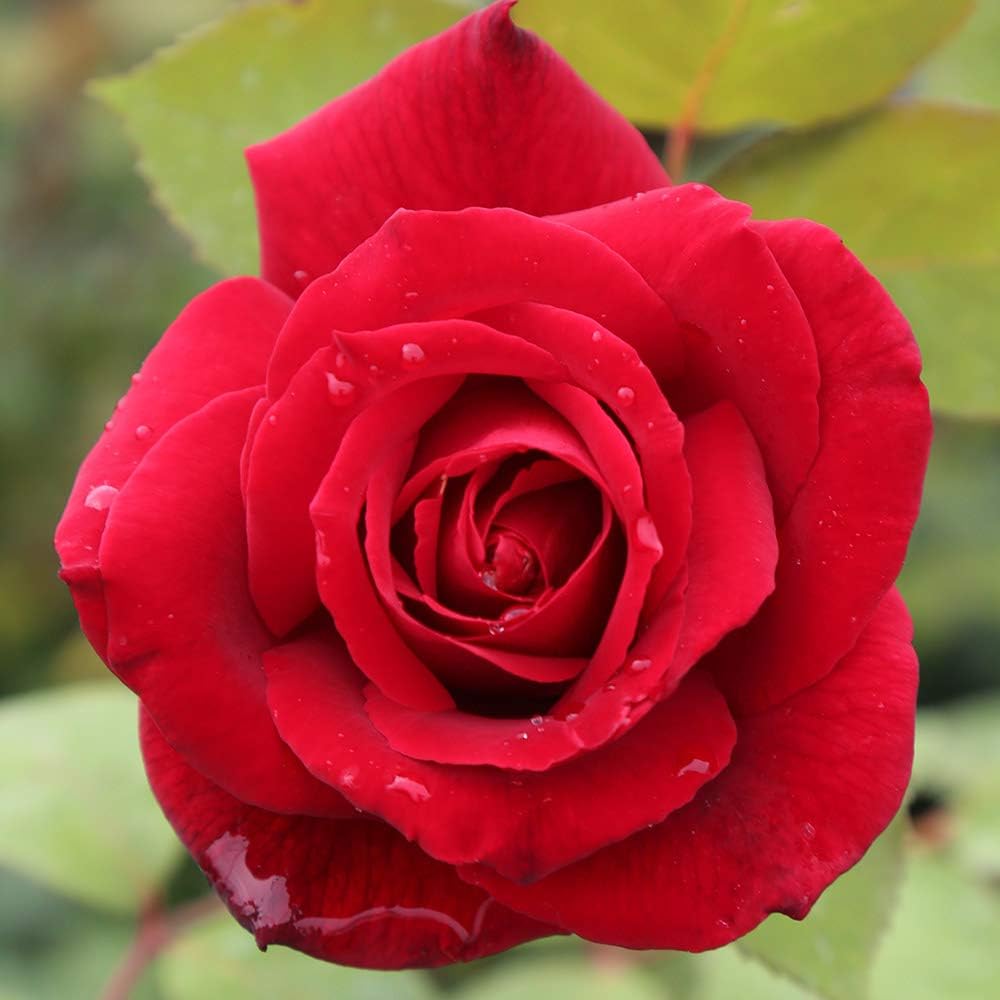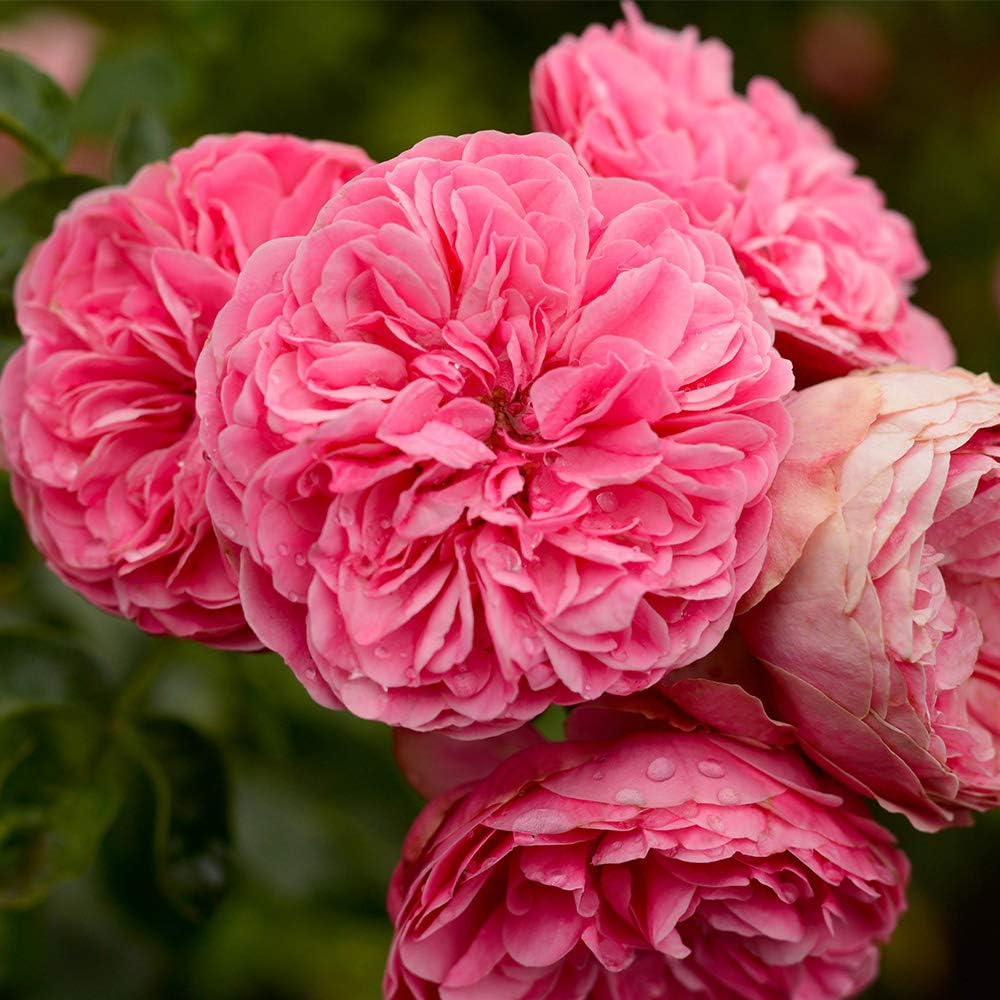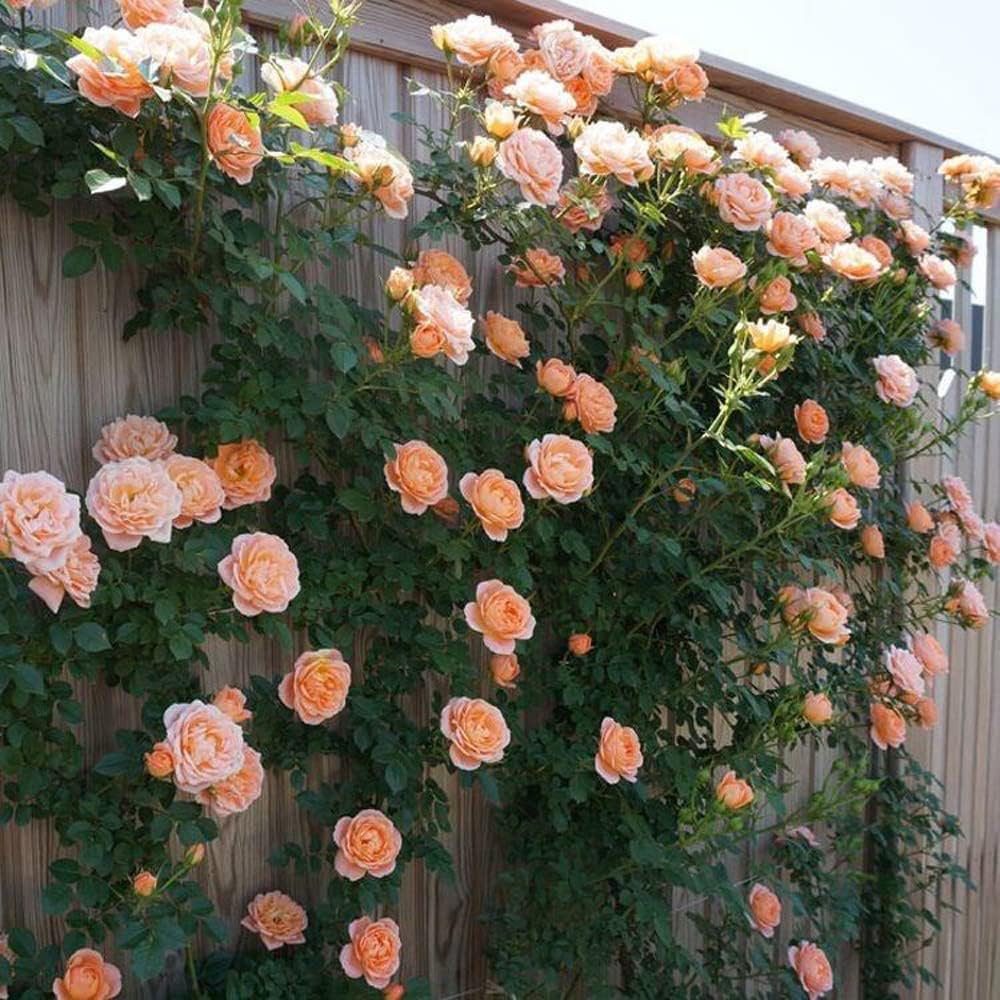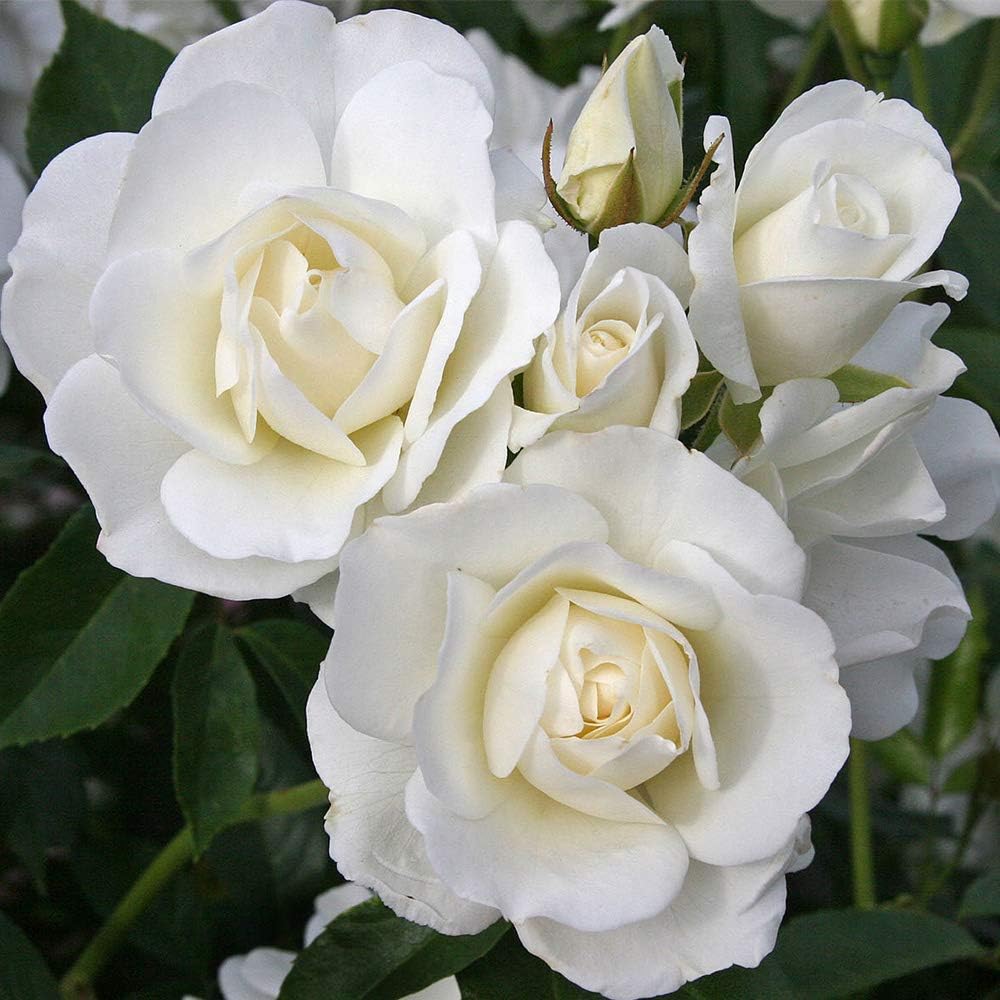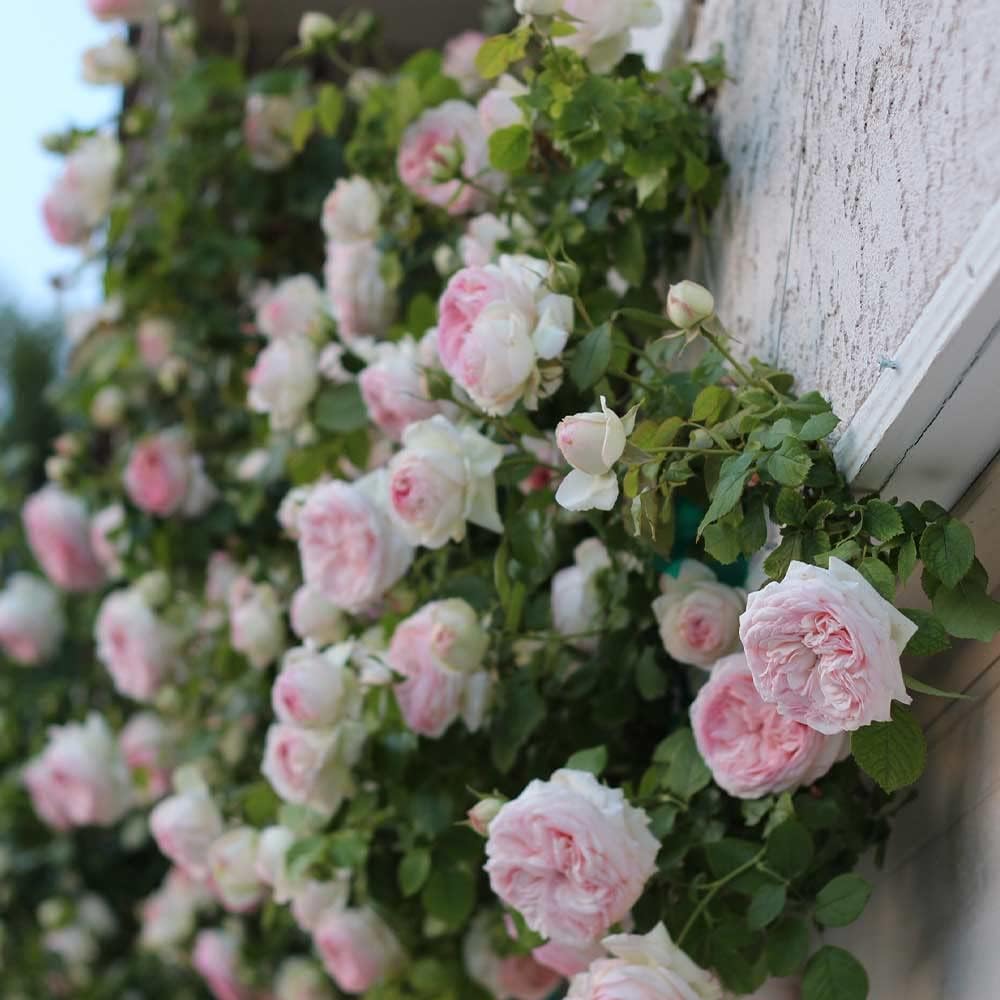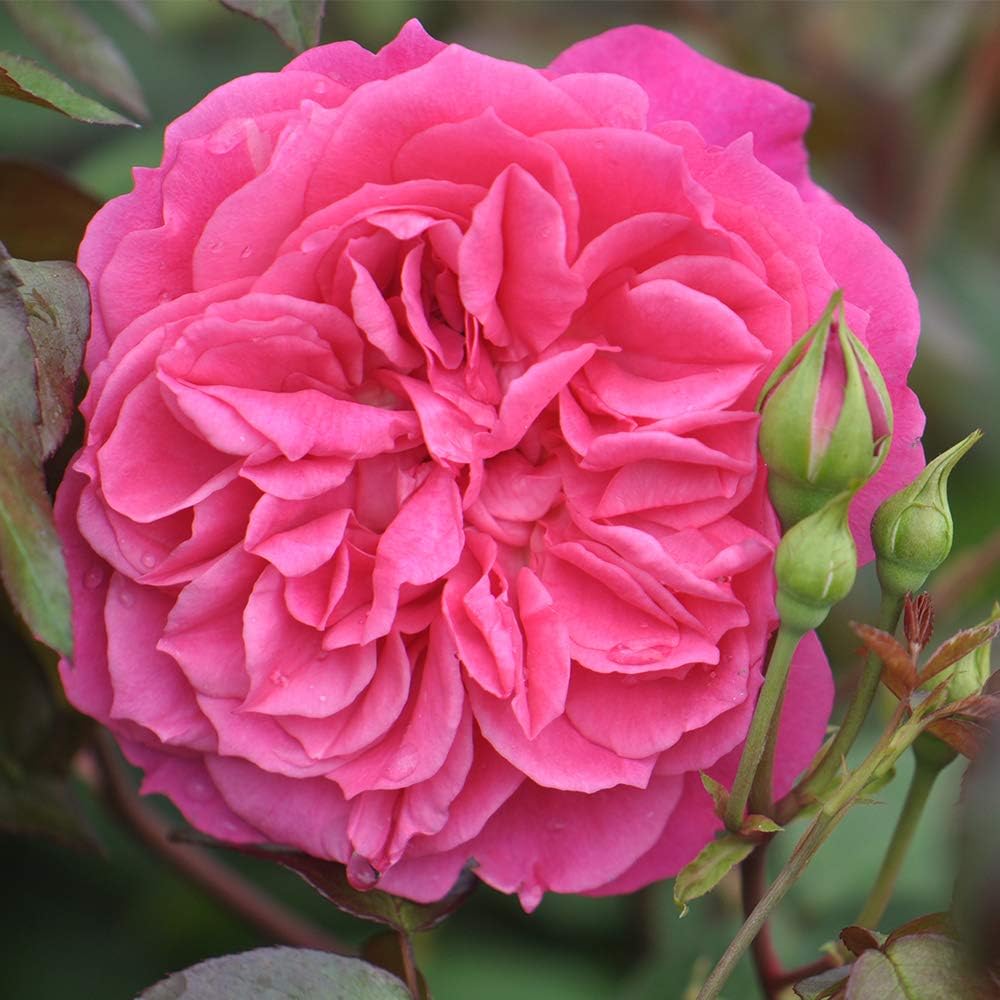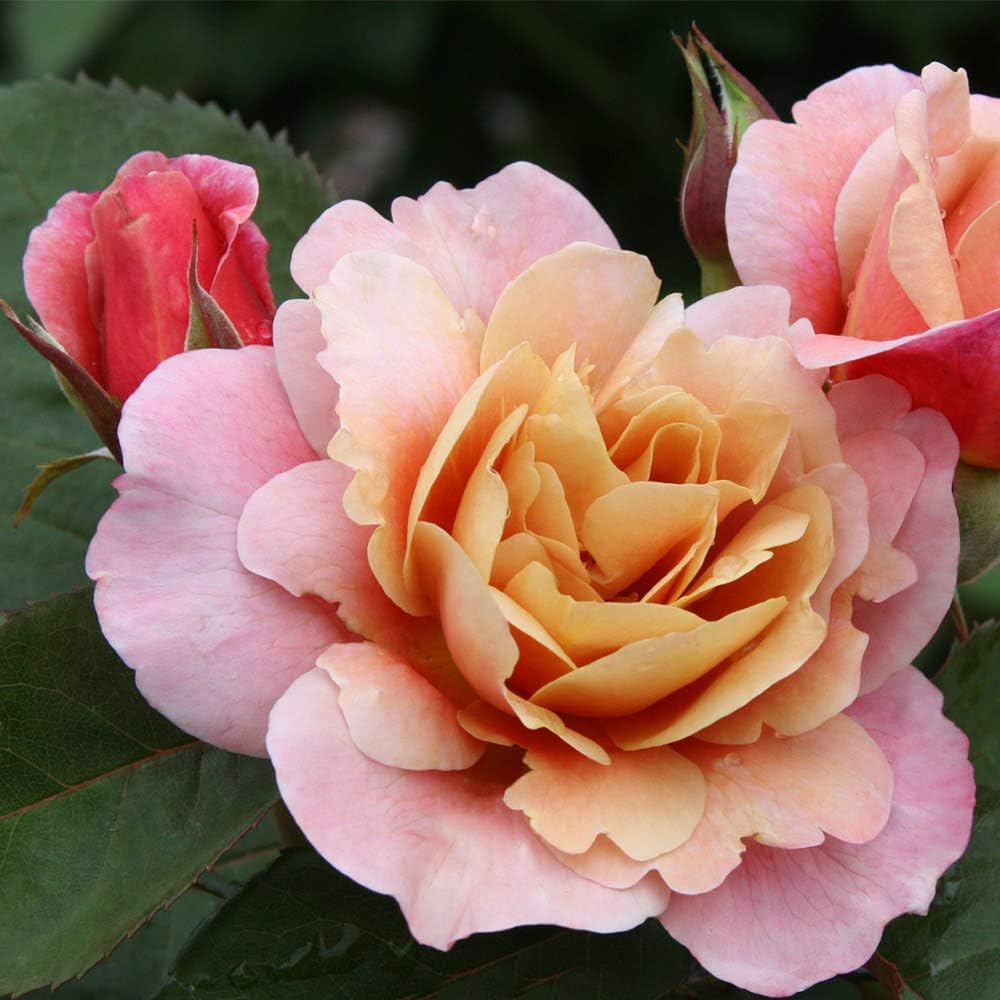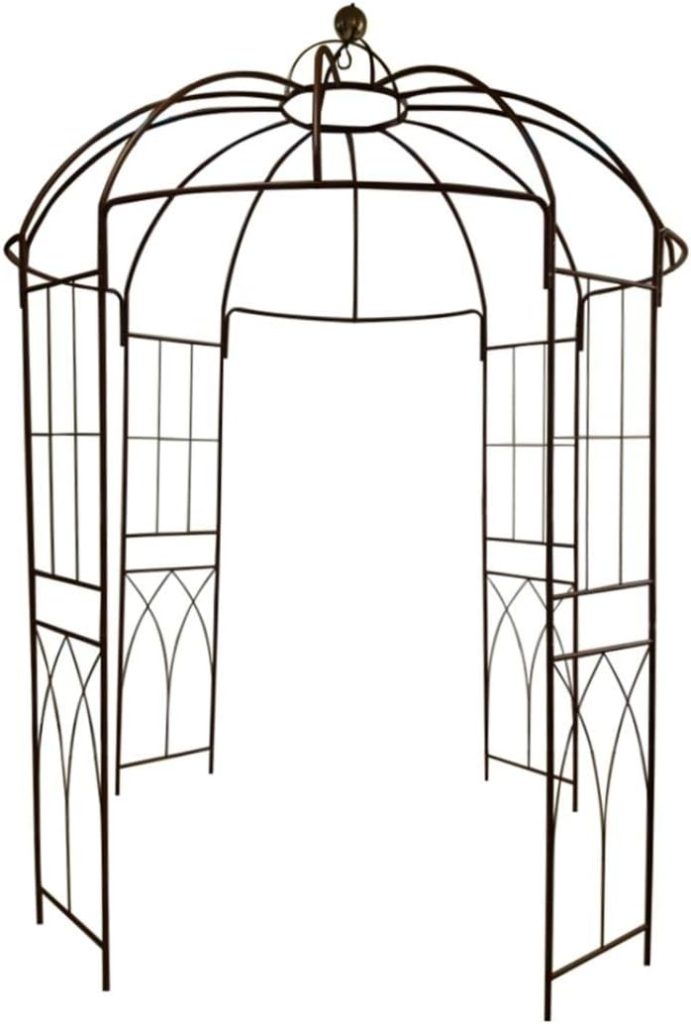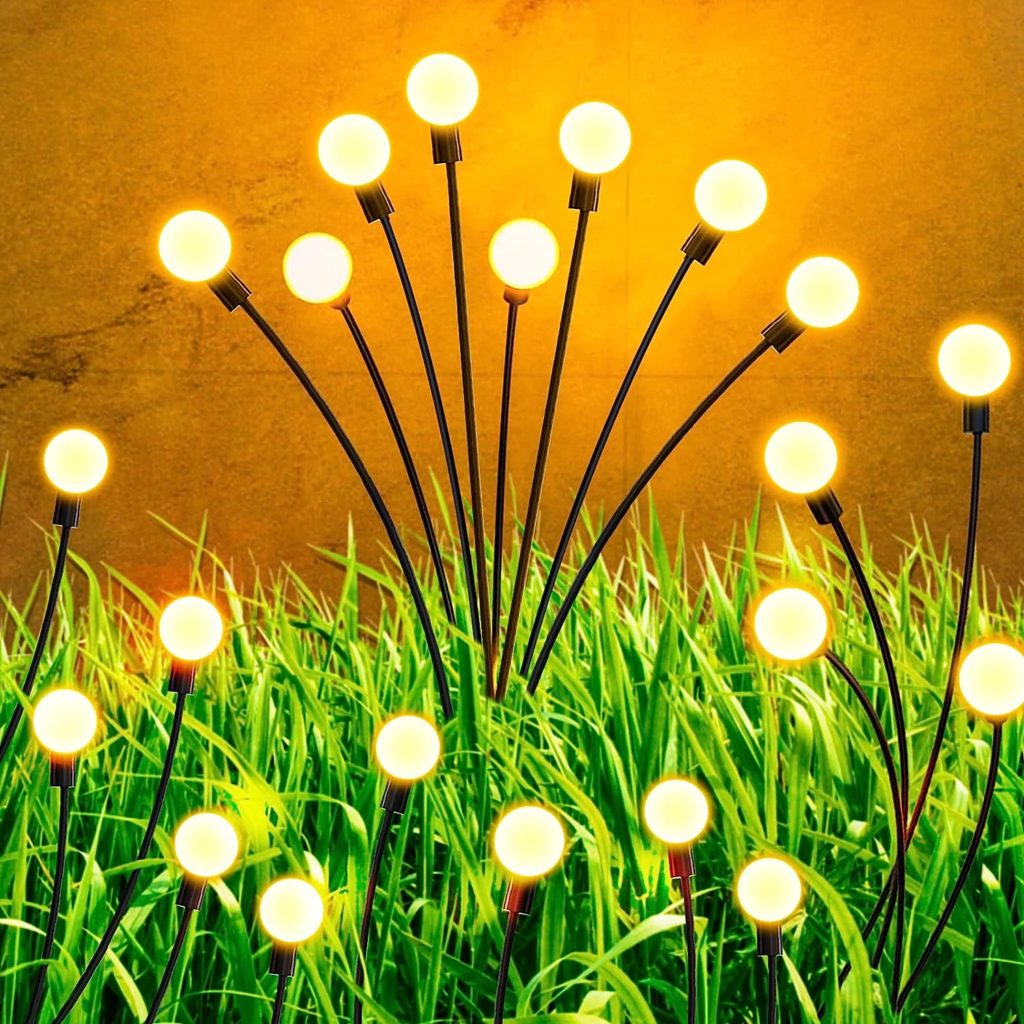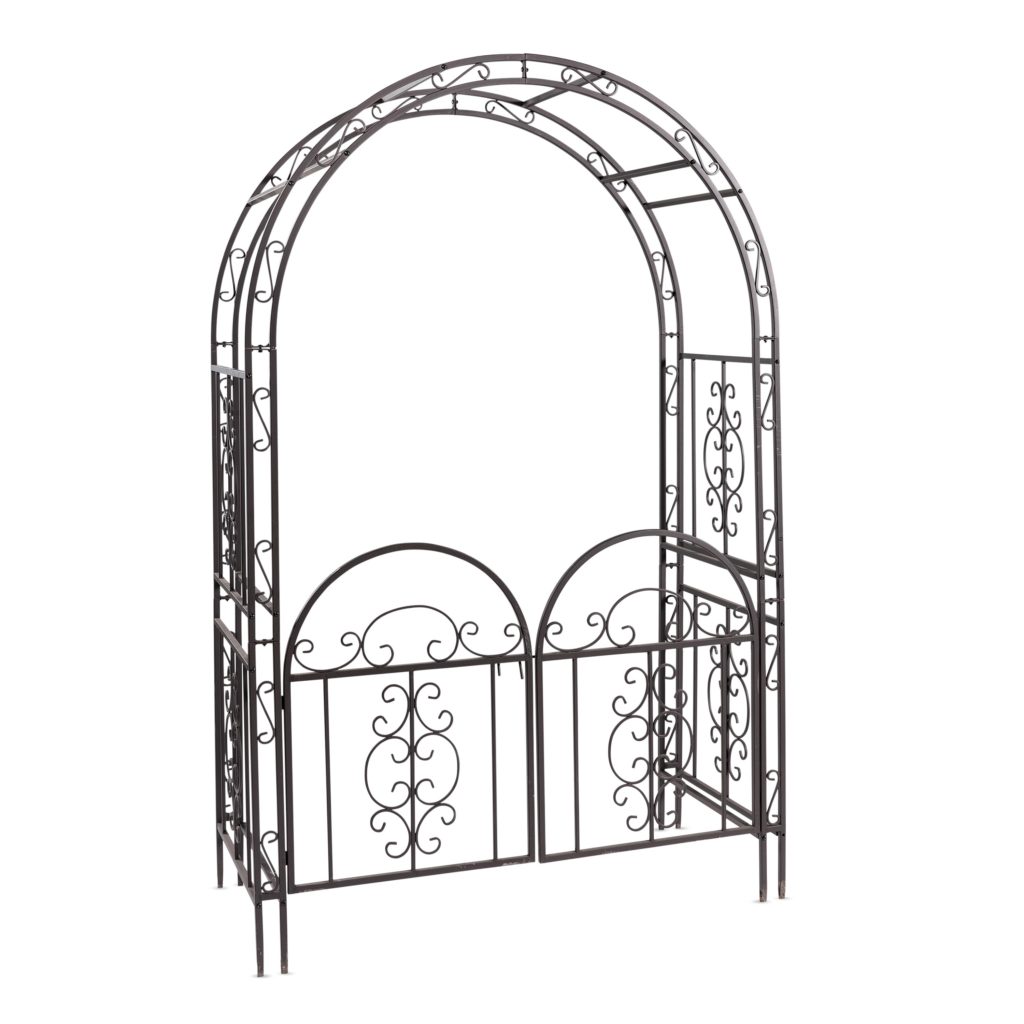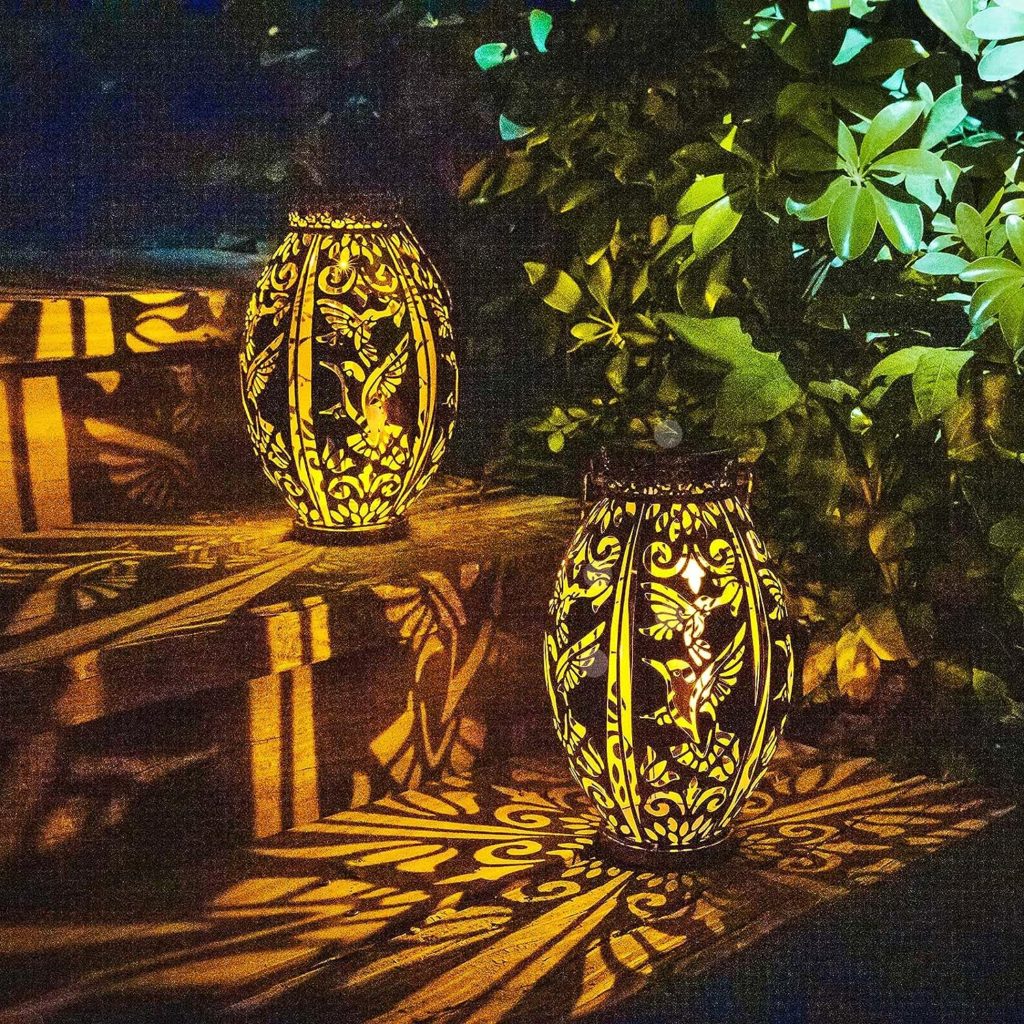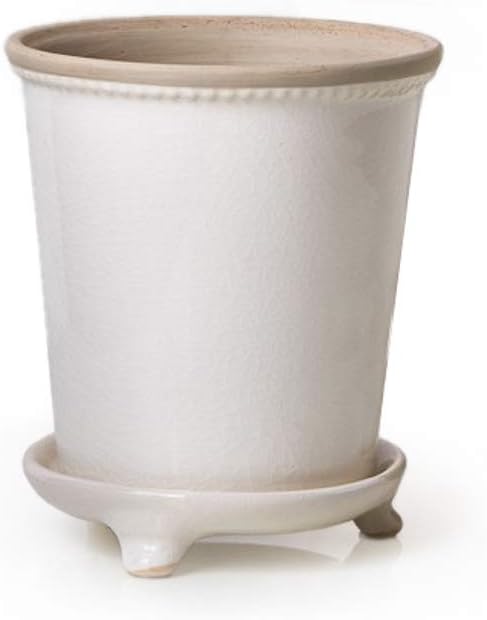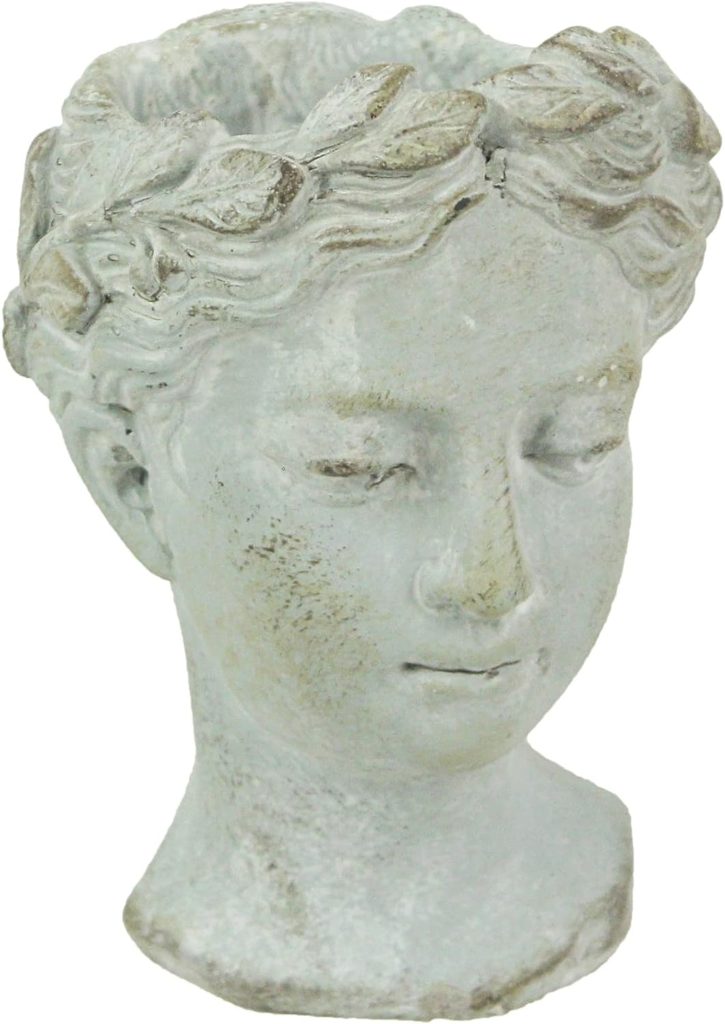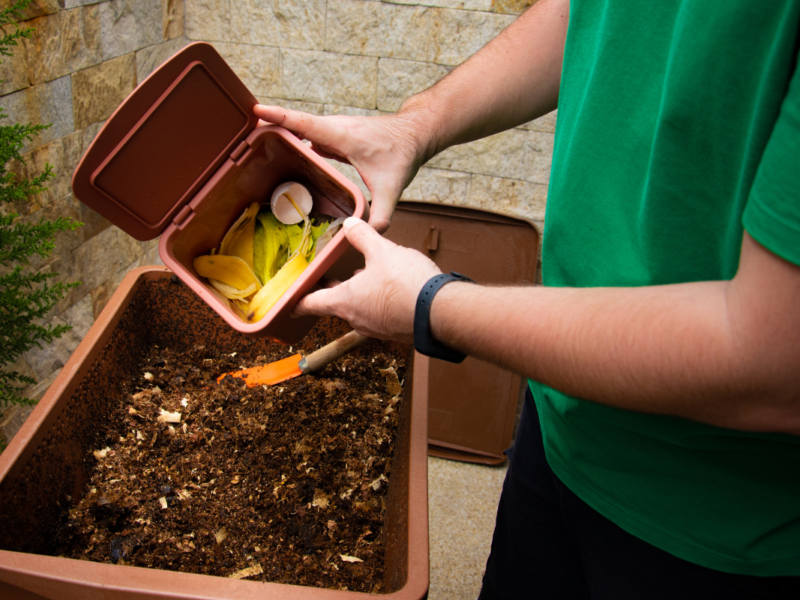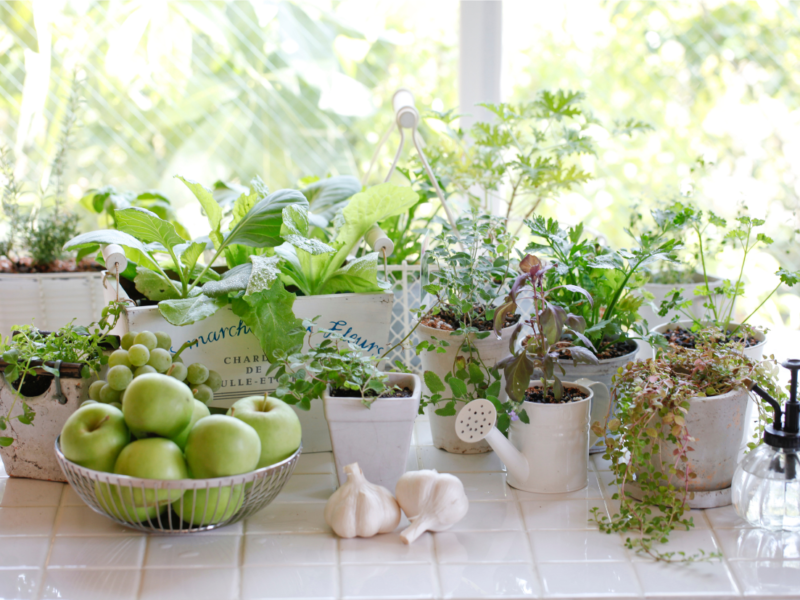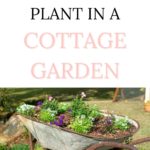Create a timeless and beautiful cottage garden that bursts colors, fragrances, and a touch of whimsy! Cottage gardens have an irresistible charm that captures the hearts of seasoned gardeners and newcomers alike. Learn what to plant in your backyard to create an enchanting cottage garden.
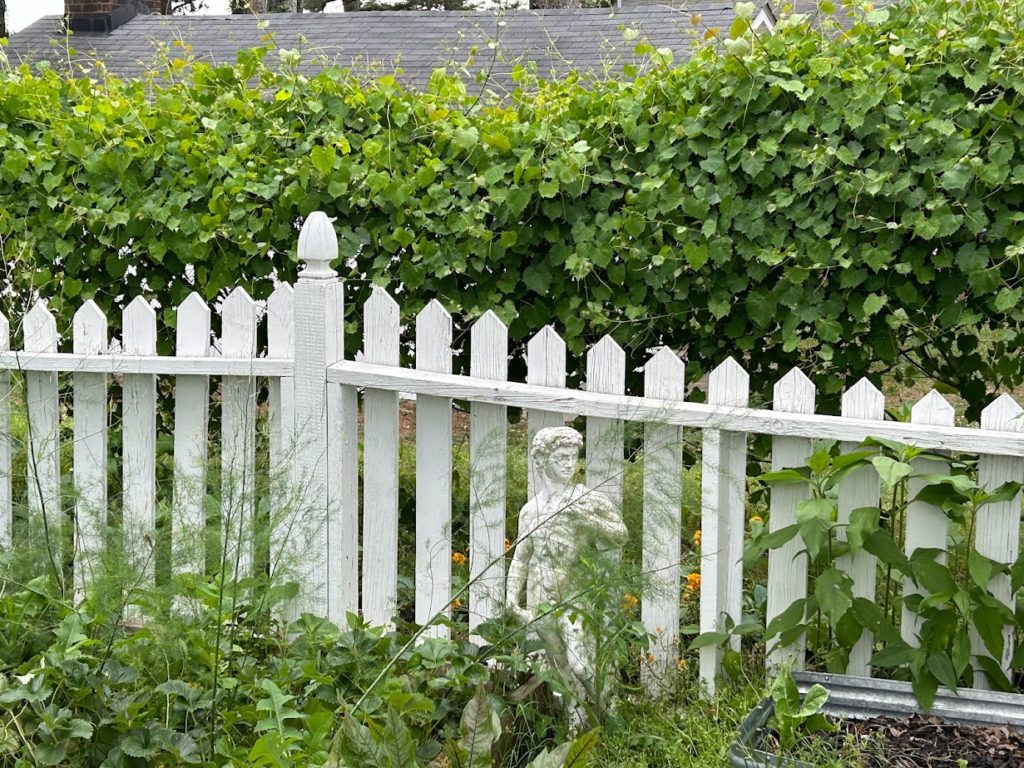
I have always loved the enchantment of an English cottage garden. American colonial gardens exhibit the familiar whimsy and tranquility of English gardens that I find so beautiful. As I attempt to create my cottage garden here on our North Carolina (Zone 8A) property, I have discovered more ways to design the perfect space.
Unearthing the Gems: Best Plants for a Cottage Garden
Read along to learn about different styles of cottage gardens, and remember to embrace your landscape. Find the plants and design elements that work well for you!
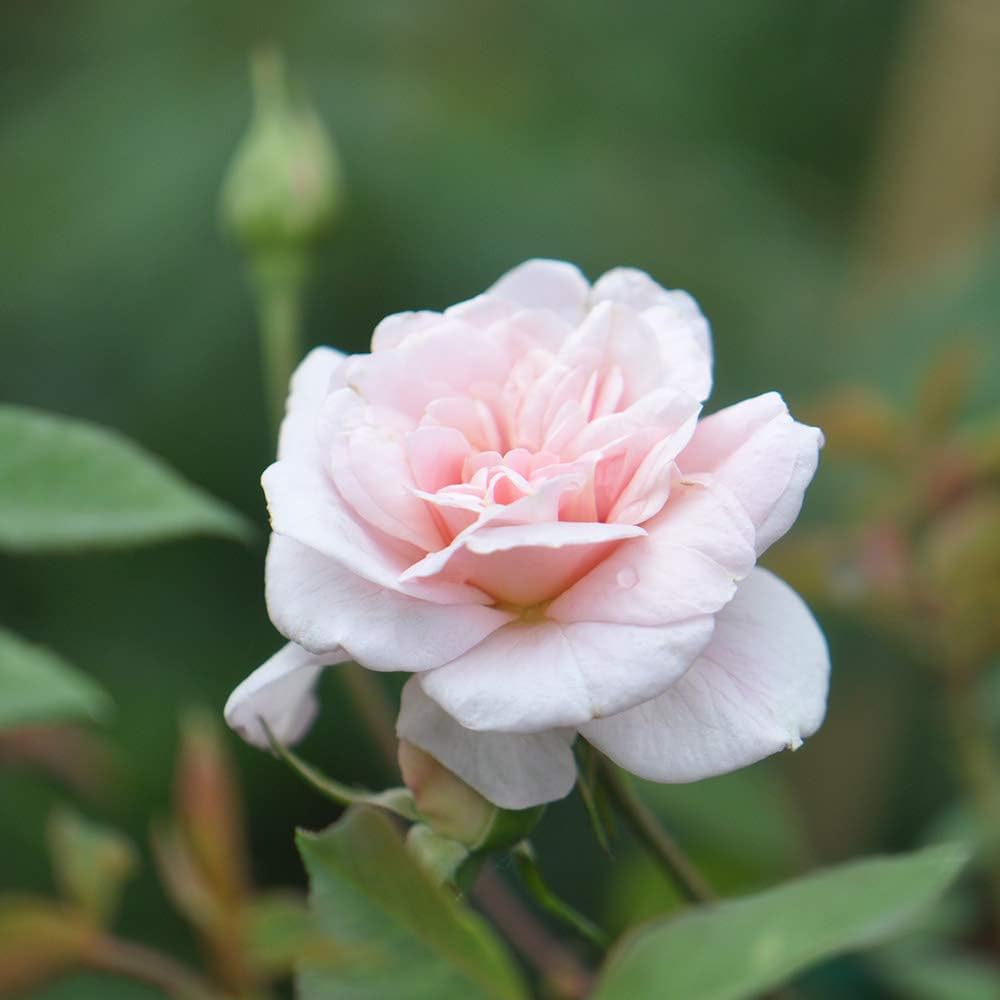
A cottage garden is a tapestry of diverse and delightful plants. The key is to create a harmonious blend of flowers, herbs, and shrubs that evoke a sense of nostalgia and natural beauty. Here are some must-have plants for your enchanting cottage garden:
Plant Cottage Garden Roses
Ah, the quintessential symbol of romance and elegance! Cottage garden roses, with their fragrant blooms and delightful hues, are a timeless addition to any English-inspired garden. There are so many beautiful varieties.
English Roses
These roses are known for their exquisite beauty, captivating fragrance, and old-fashioned charm. They often have full, cup-shaped blooms in various colors, from soft pastels to rich hues. English Roses (David Austin Roses) are repeat-flowering and blend well with other cottage garden plants due to their classic look.
Heirloom Roses
Heirloom roses, also known as old or antique roses, hold a special place in gardening. These roses are cherished for their historical significance, unique characteristics, and often captivating fragrances. Roses are exactly what to plant in a cottage garden!
Plant Climbing Roses for a Cottage Garden Vibe
Climbing roses add vertical interest to your cottage garden. They can be trained to grow up trellises, arbors, and walls, creating a romantic and picturesque atmosphere. Varieties like ‘New Dawn‘ (pale pink), ‘Climbing Iceberg’ (white), and ‘Zephirine Drouhin’ (deep pink) are popular choices for cottage gardens.
Shrub Roses
Shrub roses offer a more natural and unstructured appearance, making them an excellent fit for a cottage garden’s relaxed aesthetic. These roses have a bushy growth habit and produce clusters of blooms. Varieties like ‘The Fairy‘ (pink), ‘Bonica‘ (pink), and ‘Carefree Wonder‘ (pink) are disease-resistant and can add a cheerful and carefree vibe to your garden.
When selecting roses for your cottage garden, consider color, fragrance, growth habits, and disease resistance. Choosing a mix of these rose types can help you create a beautiful and enchanting cottage garden filled with the timeless elegance of roses.
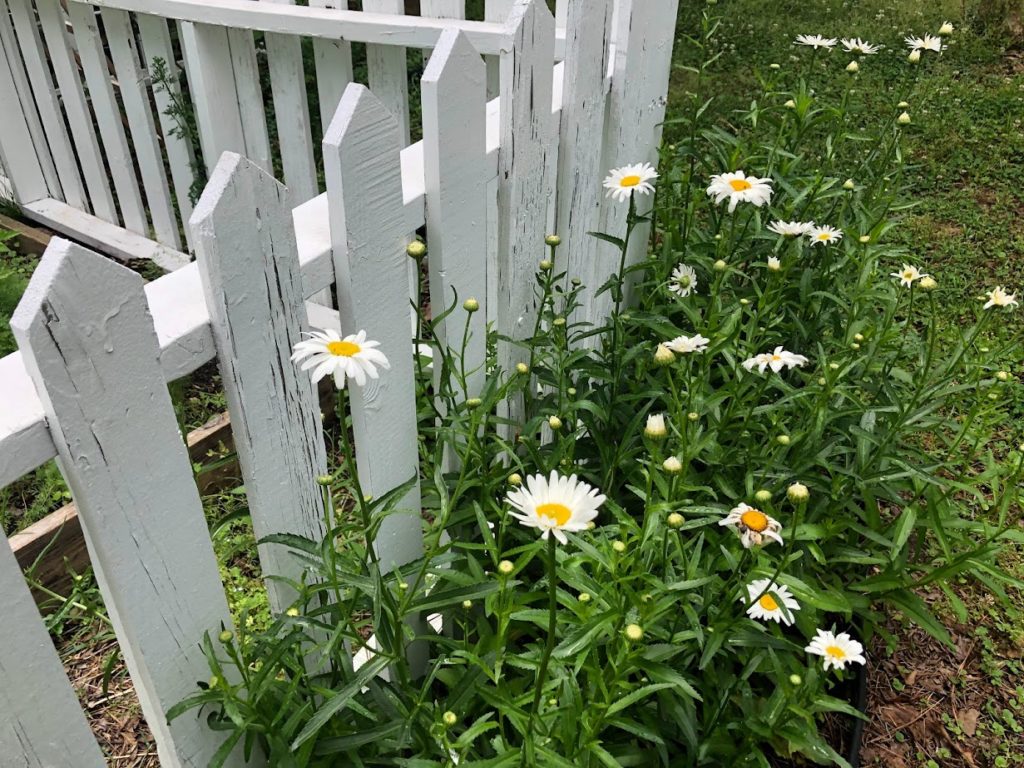
Farmhouse Flower Bed Ideas
Fill your beds with a profusion of old-fashioned favorites like Delphiniums, Hollyhocks, and Lupines. These towering beauties will add vertical interest and a touch of nostalgia to your cottage garden landscape.
What should you plant in a cottage garden? Choose lots of perennial flowers that bloom throughout the year. Mix colors and heights for whimsy and interest.
Plant Perennial Flowers in Your Romantic Cottage Garden
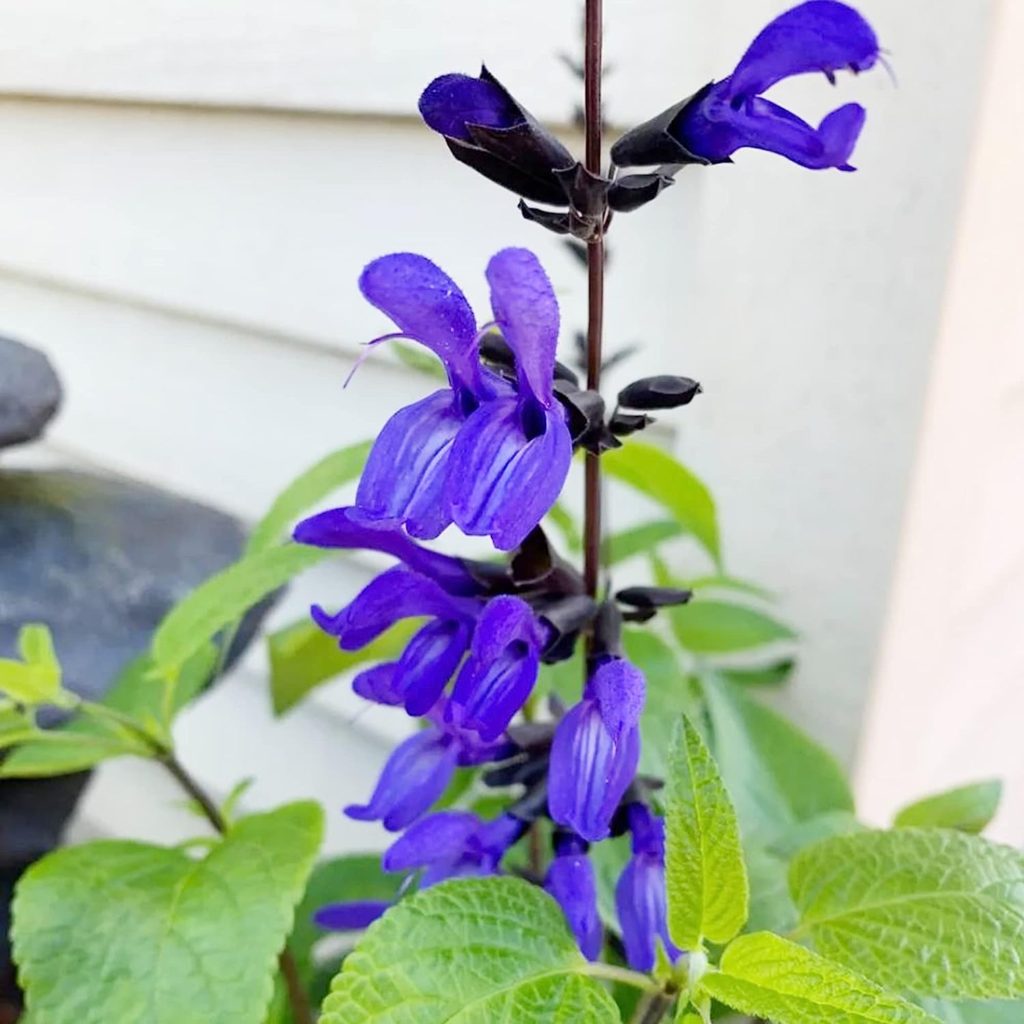
Salvia (Salvia nemorosa): These blue, pink, or purple spikes attract pollinators and add a vibrant touch to a romantic garden.
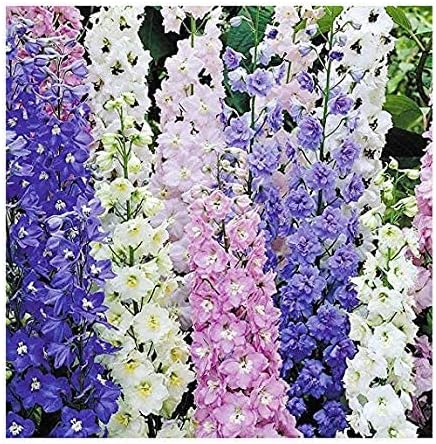
Delphinium: Tall spires of blue, pink, or white flowers create a sense of enchantment and elegance in the garden.

Shasta Daisy: Whimsical white flowers with yellow discs add joy and delight to your garden.
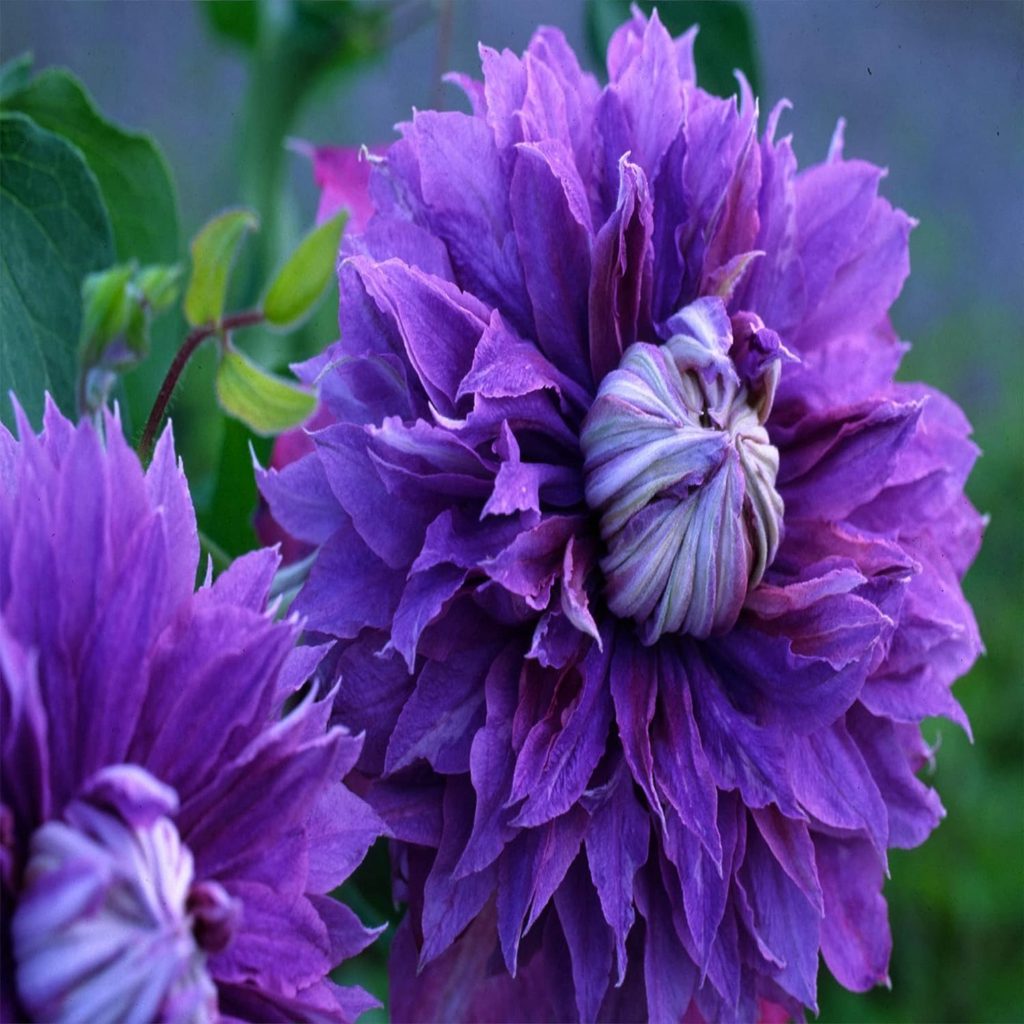
Clematis: These climbing vines produce a profusion of star-like flowers in various colors, creating a dreamy and romantic atmosphere.
More Perennial Cottage Garden Flowers
- Peony (Paeonia): Known for their large, fragrant blooms in shades of pink, white, and red, peonies exude timeless romance and grace.
- Lavender (Lavandula): The soothing fragrance and delicate spikes of lavender flowers evoke a sense of rustic romance and Provencal charm.
- Lily (Lilium): With their elegant and often fragrant blooms, lilies add a touch of refined romance to any garden.
- Hellebore (Helleborus): Also known as Lenten roses, hellebores bloom early in the year with nodding flowers in shades of pink, white, and mauve.
- Phlox: Fragrant and with a profusion of blossoms, phlox comes in various colors and adds a cheerful, romantic vibe to the garden.
- Anemone: Delicate, poppy-like flowers in shades of pink, white, or blue dance on slender stems, adding a whimsical touch to the garden.
- Canterbury Bells (Campanula): Also called bellflowers, these charming flowers dangle from slender stems, creating a romantic, cottage-garden feel.
- Bleeding Heart (Dicentra spectabilis): The heart-shaped blooms of bleeding hearts add a touch of sentimental beauty to your garden.
- Astilbe: Fluffy, feathery plumes in shades of pink, white, and red lend a soft and romantic look to the garden.
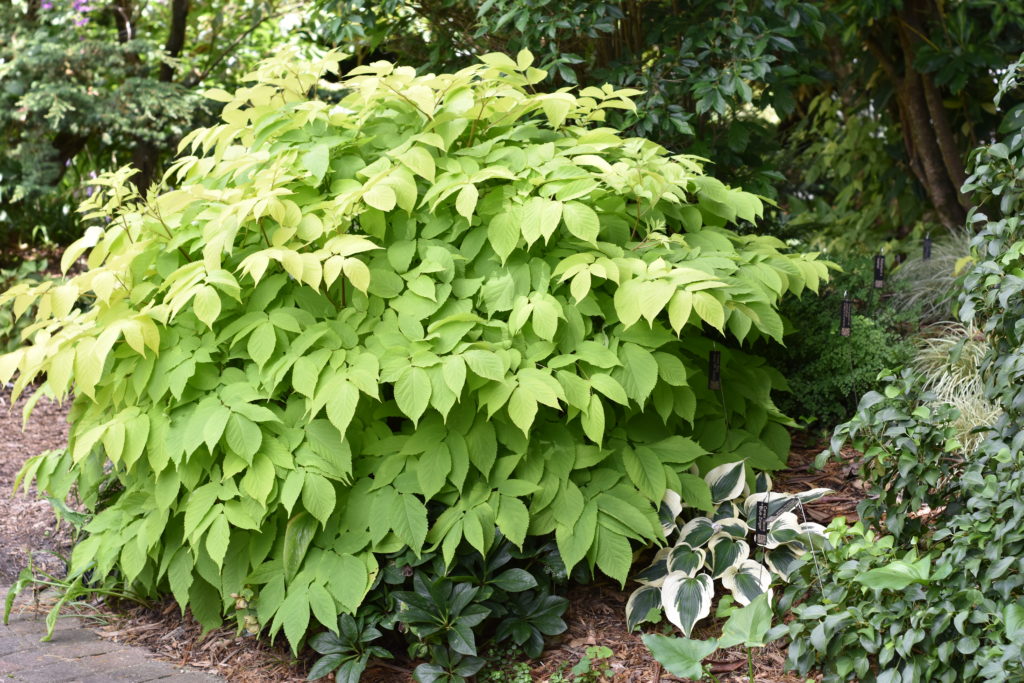
Shade Plants for the Cottage Garden
Embrace the beauty of shade-loving plants like Bleeding Hearts, Foxgloves, and Ferns. These delicate yet hardy plants will flourish in dappled sunlight and add a touch of mystery to the corners of your garden.
Creating a charming cottage garden in a shady area requires selecting plants that thrive in low-light conditions.
Here’s a list of shade-loving plants that can bring a touch of enchantment to your cottage garden:
- Hosta (Hosta spp.): Known for their diverse foliage patterns and colors, hostas add texture and elegance to shady areas.
- Ferns: Various fern varieties, such as lady ferns (Athyrium spp.) and ostrich ferns (Matteuccia struthiopteris), thrive in the shade and offer lush, delicate foliage.
- Lungwort (Pulmonaria spp.): Lungwort features spotted leaves and clusters of pink, purple, or blue flowers, creating a whimsical atmosphere.
- Columbine (Aquilegia spp.): Delicate, bell-shaped flowers in various colors add a graceful and cottage-like character to shady spots.
- Japanese Forest Grass (Hakonechloa macra): This ornamental grass offers gracefully arching foliage in shades of green or variegated patterns.
- Jacob’s Ladder (Polemonium spp.): This plant boasts clusters of small, star-shaped flowers in shades of blue, pink, or white.
- Brunnera (Brunnera macrophylla): Known for its heart-shaped leaves and small blue flowers, Brunnera adds a gentle beauty to shade gardens.
- Sweet Woodruff (Galium odoratum): Fragrant, star-shaped flowers and bright green foliage create a carpet-like effect in shaded areas.
- Coral Bells (Heuchera spp.): Available in a range of foliage colors, coral bells offer both texture and color to shade gardens.
When planning your cottage garden in a shady area, consider combining various shade-loving plants to create a lush and inviting oasis filled with texture, color, and character.
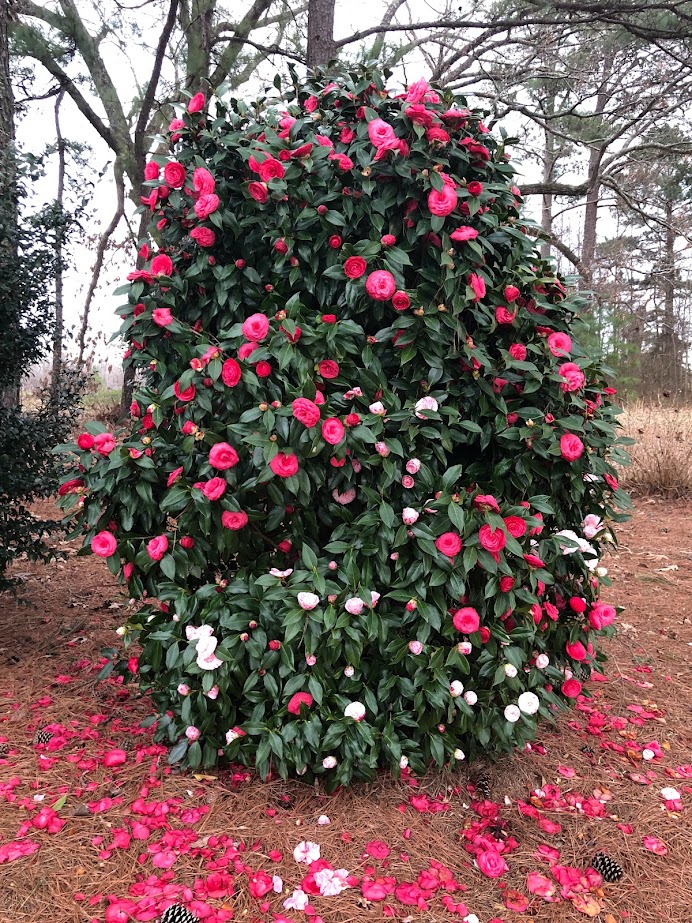
Plant These Trees and Shrubs in Your Cottage Garden
A cottage garden is only complete with the graceful presence of trees, hedges, and shrubs. Planting trees in a cottage garden can add charm, character, and shade to your outdoor space.
When choosing trees for a cottage garden, consider factors such as size, aesthetics, maintenance, and compatibility with the overall theme of your garden. Here are some tree options that can work well in a cottage garden:
Fruit Trees
Fruit trees like apples, pears, cherries, or plums can provide beauty and edible rewards. They fit well with the rustic, productive feel of a cottage garden.
Flowering Trees
Flowering trees like dogwood, magnolia, or redbud can add color and visual interest to your garden. They also attract pollinators and enhance the overall ambiance.
Small Ornamental Trees
Small ornamental trees such as crabapple, Japanese maple, or flowering cherry can provide a focal point without overwhelming the garden space.
Columnar Trees
Columnar trees like Italian cypress or columnar apple trees can add vertical accents and create a sense of structure in your garden.
Topiary and Hedges
Consider using classic Boxwood hedges, charming Rose topiaries, and fragrant Lavender hedges in a cottage garden to add structure and whimsical accents.
Native Trees
Consider planting native trees well-suited to your region’s climate and ecosystem. They often require less maintenance and provide habitat for local wildlife.
Willow Trees
Willow trees have a romantic, whimsical quality that can complement the cottage garden style. Their graceful branches and leaves can create a serene atmosphere.
Birch Trees
Birch trees, with their distinctive white bark, can add a touch of elegance and contrast to your garden’s color palette.
Lilacs
Lilacs produce lovely fragrant flowers and add a nostalgic and traditional cottage garden feel.
Camelias
Camellias come in many varieties and colors. They have waxy, lush evergreen leaves and rose-like blooms. We have mature camellias on our property. If you are lucky to have shrubs like these, you can design your cottage garden around them.
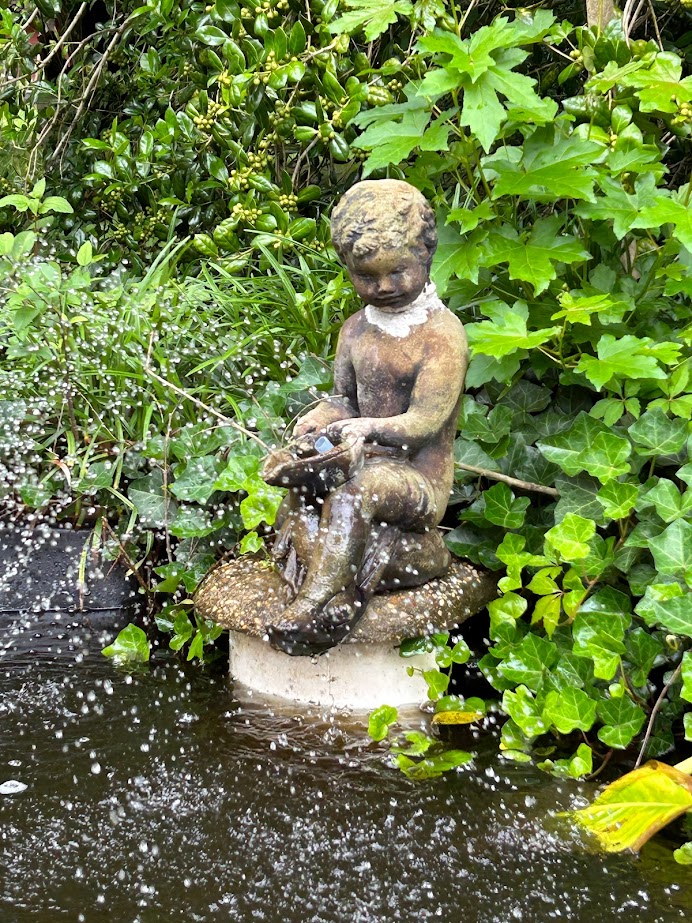
Vintage Cottage Garden Containers and Planters
Repurpose vintage containers like tin buckets, old watering cans, and wooden crates to create whimsical planters for your favorite blooms. The juxtaposition of old-world charm with vibrant flowers will make your garden unique.
We spend the weekends browsing thrift and vintage stores for gardening goods! I have found many statues and pottery that add character to our space. Also, I salvaged our garden fence from a nearby antique store! All the proceeds go to a cat and dog rescue, so it was a WIN-WIN!
Cultivating Cottagecore: Designing Your Cottage Garden
Now that we’ve uncovered the best plants let’s explore some design ideas to turn your cottage garden dreams into a reality.
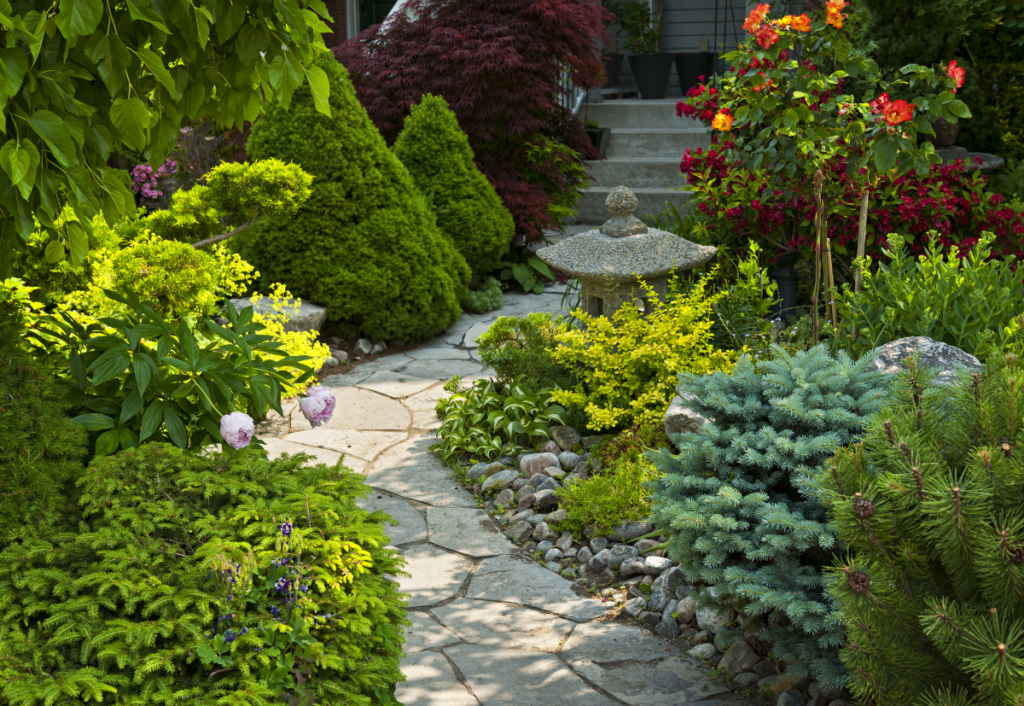
French Cottage Garden Elegance
Infuse your garden with French sophistication by incorporating neatly trimmed hedges, trellises adorned with climbing roses, and gravel pathways leading to hidden corners.
A French cottage garden, a “petit jardin de curé” embodies a delightful blend of formal elegance and rustic charm. Inspired by the picturesque landscapes of the French countryside, this garden style features a harmonious balance between organized design and a profusion of diverse plants.
Design Your Cottage Garden with French Inspiration
Pathways and Layout
A French cottage garden is typically organized around a central axis, creating a sense of symmetry and order.
Gravel or stone pathways, often lined with neatly trimmed hedges or borders, guide visitors through the garden. These pathways may lead to a central focal point, such as a statue, fountain, or a small seating area.
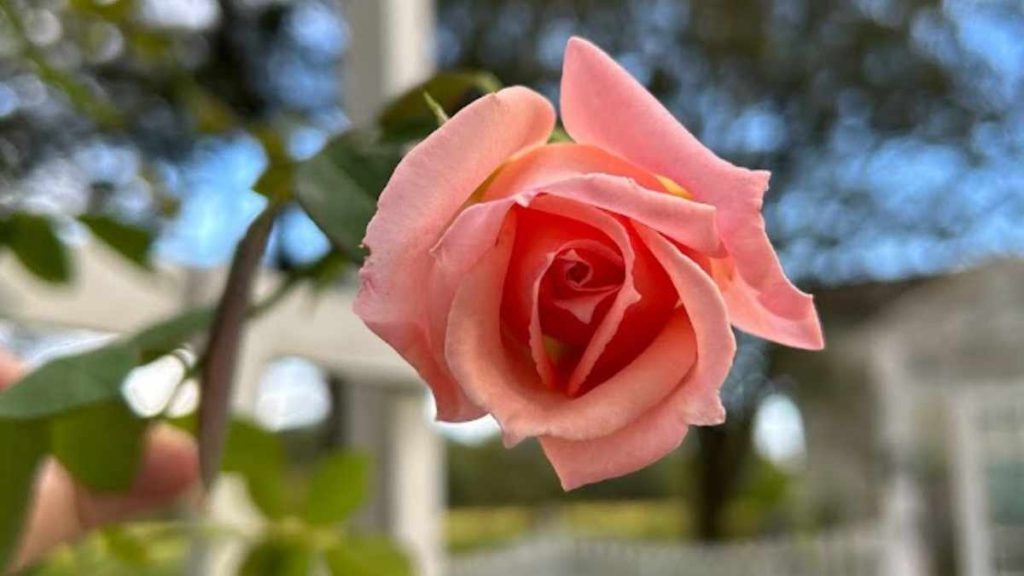
Plant Selection
Flowers are the heart of a French cottage garden. Various flowering plants are arranged to create color-themed borders and beds.
Classic flowers like roses, lavender, peonies, and delphiniums are staples of the park, lending an air of romance and elegance. Other cottage gardens favorites like foxgloves, hollyhocks, and iris may also find their place.
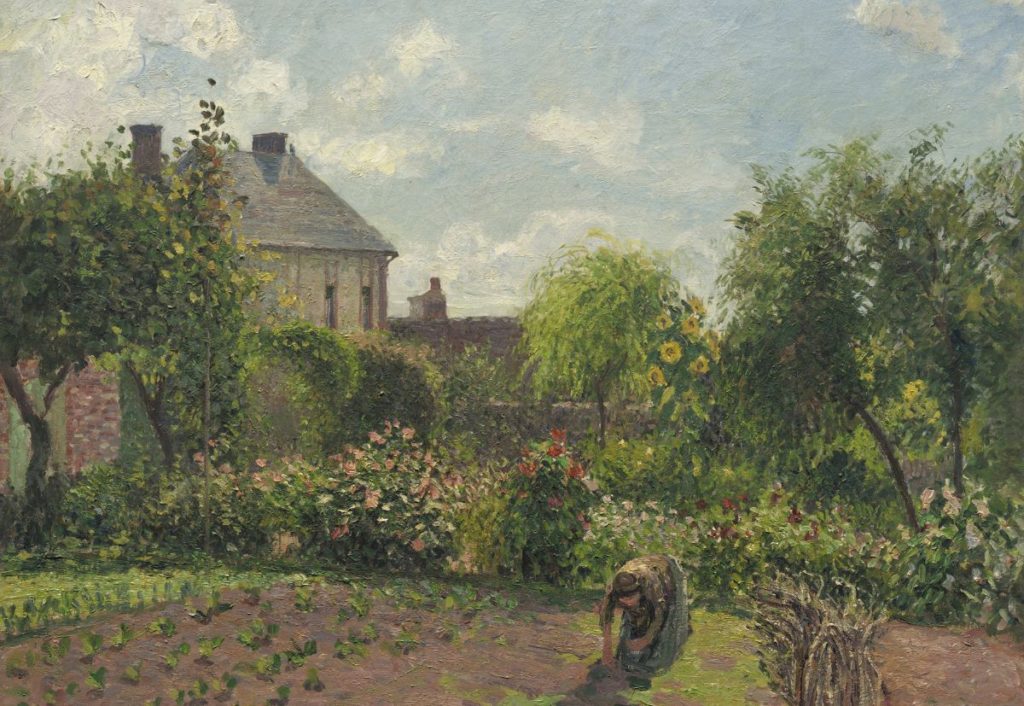
Formal and Informal Elements
While the layout and symmetry have a sense of formality, a French cottage garden embraces a relaxed informality in its plantings. Plants can spill over pathways and blend in a harmonious tapestry. Climbing roses may adorn trellises and archways, while fruit trees and shrubs contribute to the productive and pastoral feel of the garden.
Structures and Accents for the French Cottage Garden
Traditional architectural elements play a significant role in a French cottage garden. Stone walls, wrought iron gates, arbors, and pergolas add vertical interest and support climbing plants.
Rustic benches and quaint seating areas provide spots for contemplation and enjoyment of the surroundings. Terracotta pots and containers filled with herbs and flowers add charming details.
Plant Herbs and Vegetables in the Cottage Garden
A French cottage garden often incorporates a practical side with a section dedicated to growing herbs and vegetables.
These functional areas are usually well-integrated into the overall design, enhancing the garden’s productivity and connecting to traditional agricultural practices.
Wildlife and Sustainability in the French Cottage Garden
A French cottage garden supports local biodiversity by attracting pollinators like bees and butterflies.
The use of organic gardening practices, companion planting, and natural pest control methods aligns with the garden’s emphasis on sustainability and harmony with nature.
Overall, a French cottage garden is a visual masterpiece that captures the essence of rustic elegance, showcasing the French passion for beauty, nature, and the art of living.
What to Plant in an English Cottage Garden
An English cottage garden is a charming and quintessentially English style of gardening that exudes a romantic and informal beauty. It blends various ornamental and practical plants in a relaxed yet harmonious design. Here’s a description of an English cottage garden:
Plant Diversity
An English cottage garden is a tapestry of colors, textures, and scents. It features a rich mix of flowering plants, herbs, and sometimes even small fruit trees, all densely planted together.
Traditional cottage garden plants include roses, foxgloves, hollyhocks, lupines, delphiniums, and poppies, creating a lush and vibrant display.
English Cottage Gardens Need Cascading Borders
The garden is characterized by its flowing, seemingly unstructured borders. Plants spill over pathways and intermingle with one another, giving the garden a natural and slightly wild appearance.
The use of self-seeding plants contributes to this charmingly haphazard look. Relax and embrace the whimsy in your English-inspired cottage-core garden.
Pathways and Seating
Curving gravel pathways wind through the garden, guiding visitors on a stroll to explore the various plantings.
Quaint benches, wooden or wrought iron, are strategically placed to offer spots for contemplation and enjoyment of the surroundings.
Climbing and Trailing Plants in the English Cottage Garden
Climbing roses, clematis, and other vines adorn arbors, trellises, and walls, adding vertical interest and a touch of romance to the garden. These plants often create a sense of height and structure within the otherwise informal design.
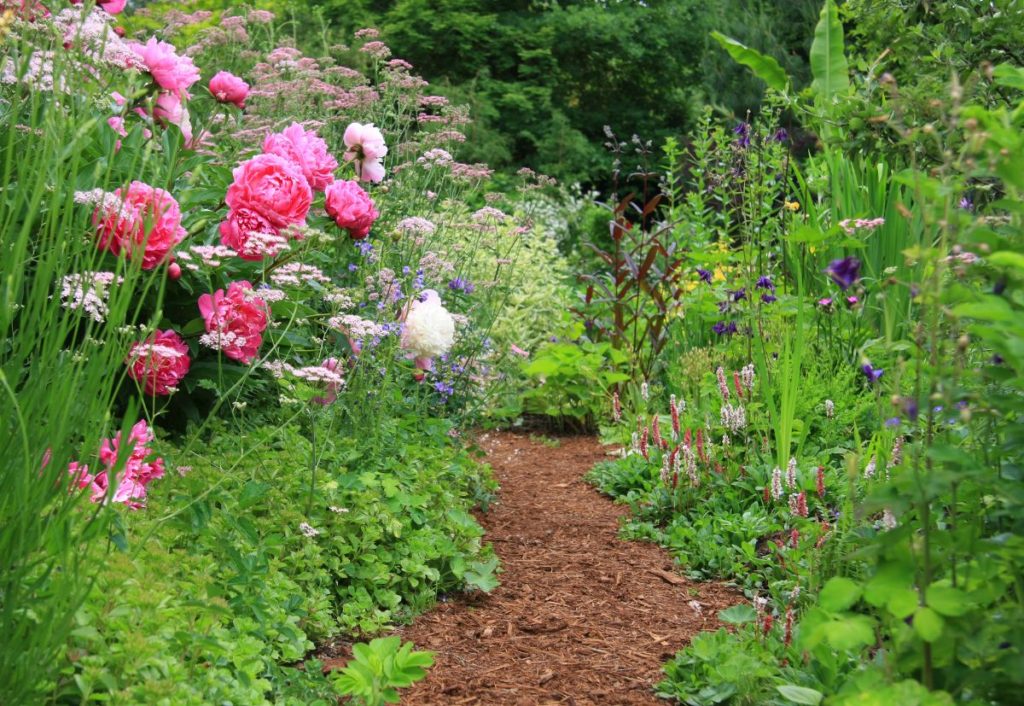
Fragrance and Sound
Fragrance plays a significant role in an English cottage garden. The air is often scented with the delightful aromas of roses, lavender, sweet peas, and other fragrant flowers.
The park is alive with the buzzing of bees, the trilling of songbirds, and the gentle rustling of leaves in the breeze.
Plant varieties of thyme and mint along the pathways to keep weeds at bay and create an aroma as you stroll through the garden.
A Wildlife Haven in the English Garden
An English cottage garden is an inviting habitat for wildlife. Pollinators like bees and butterflies are drawn to the nectar-rich blooms, while birds find shelter and nesting sites amidst the dense plantings. The garden’s biodiversity creates a dynamic ecosystem that enriches the natural beauty.
Informal Garden Structures
Simple, rustic structures such as wooden arches, arbors, and low stone walls may be used to define spaces within the garden. These structures often support climbing plants and serve as charming focal points.
Edible Elements
Besides ornamental plants, an English cottage garden might include a small space for growing herbs, vegetables, and fruits. These functional elements are integrated seamlessly into the garden’s overall design.
Overall, an English cottage garden is a delightful blend of nature’s abundance and the art of gardening, creating a picturesque and inviting outdoor retreat that captures the essence of English countryside living.
Embrace the Cottagecore Aesthetic
The rise of “cottagecore” has captured the hearts of many, and it’s the perfect fit for your garden too! Add whimsical elements like fairy lights, vintage birdhouses, and rustic benches to create a cozy and nostalgic ambiance.
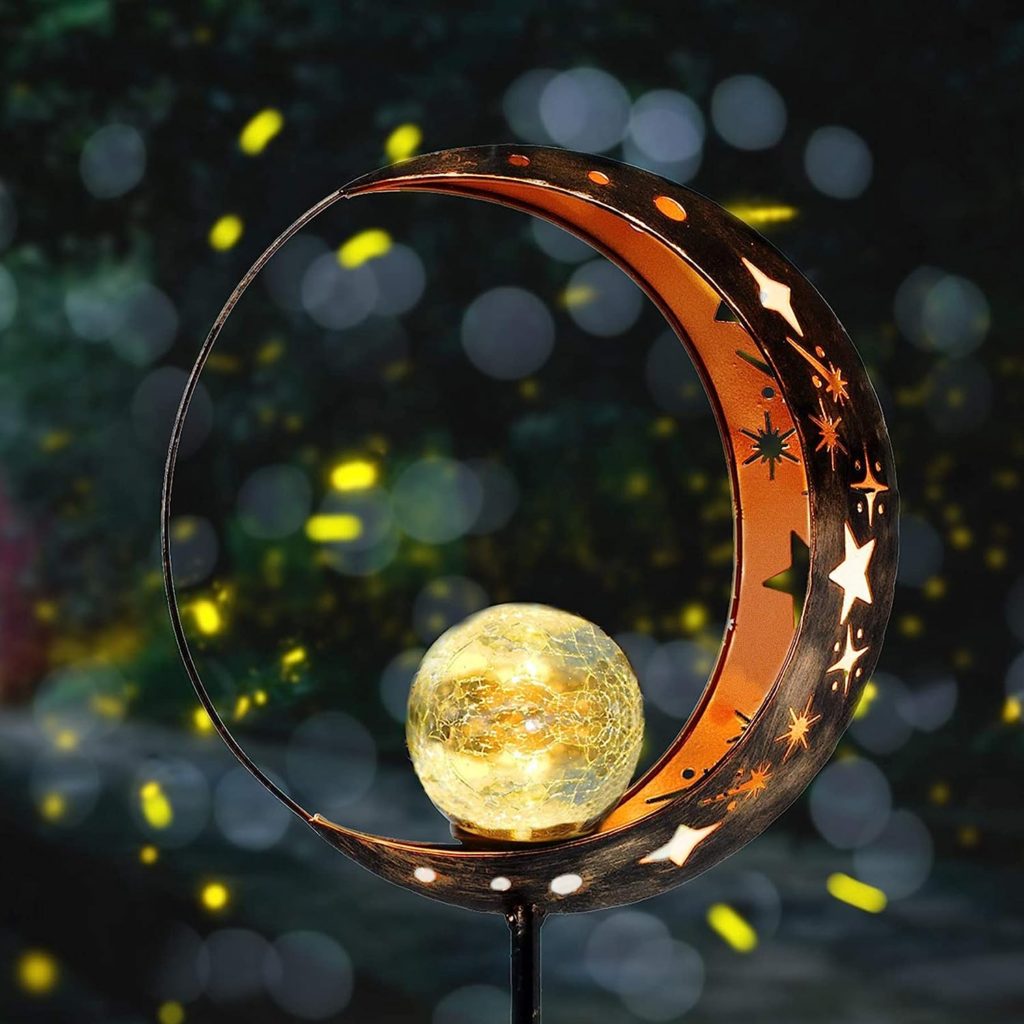
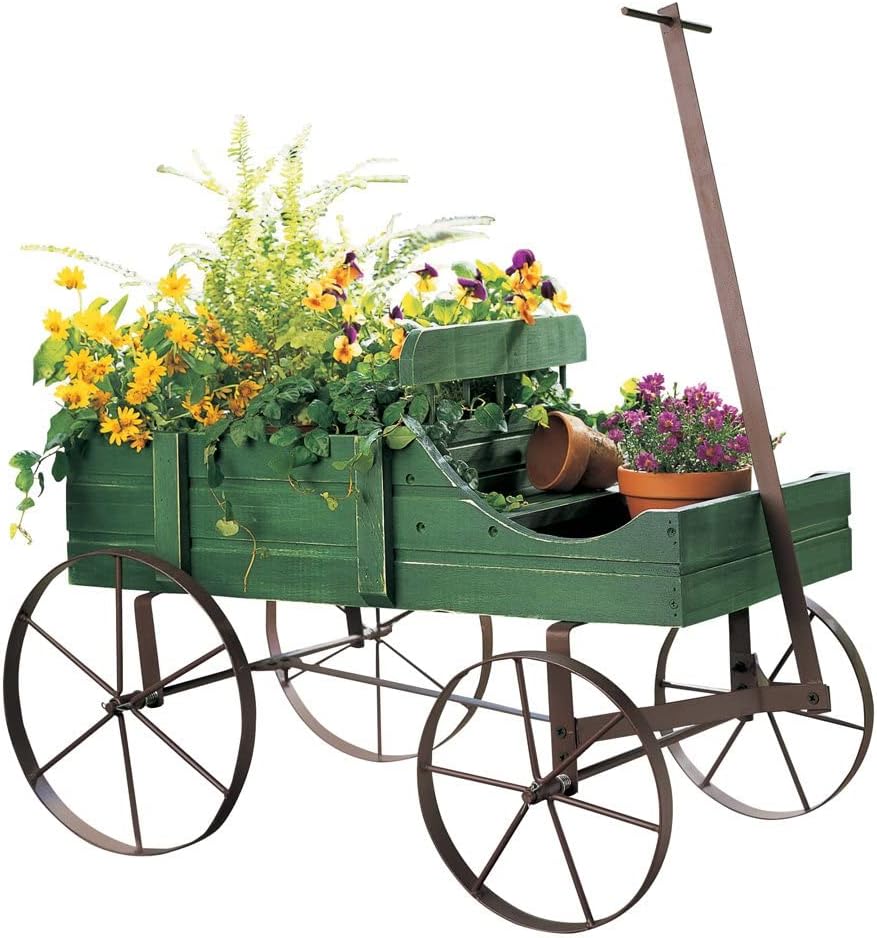
The Modern Cottage Garden
Give your cottage garden a contemporary twist by combining traditional cottage plants with modern accents. Try incorporating ornamental grasses, succulents, or architectural sculptures for a fresh take on this classic style.
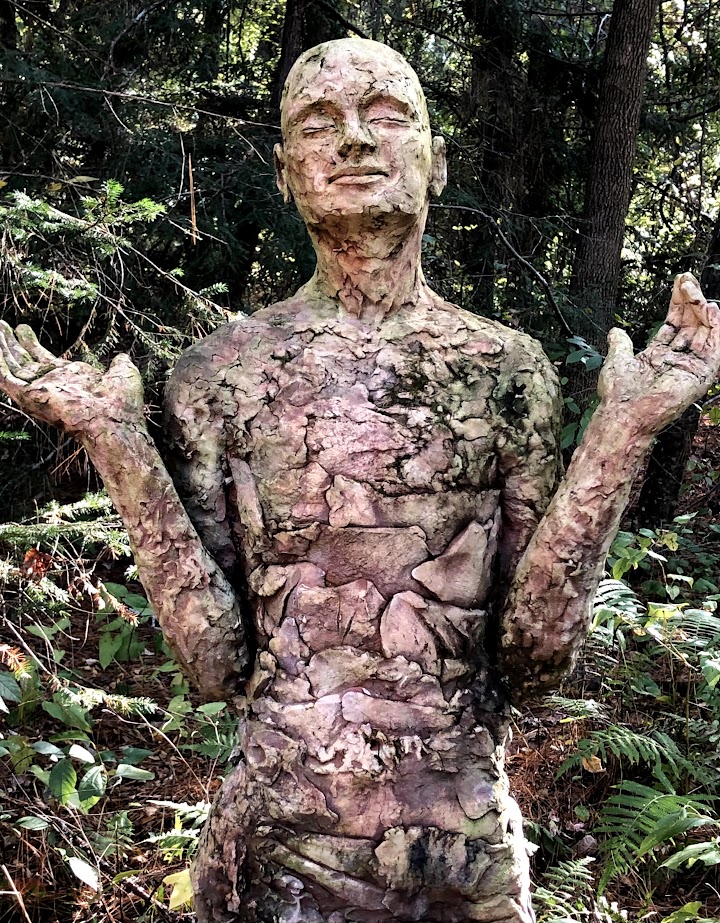
A modern cottage garden differs from traditional English and French cottage gardens in several key ways:
Design Aesthetics
While traditional English and French cottage gardens have a more relaxed and informal design with a mix of densely planted, free-flowing flowers, a modern cottage garden incorporates clean lines, geometric shapes, and a more minimalist approach to design, often inspired by contemporary landscaping principles.
Plant Selection
While English and French cottage gardens often feature a wide variety of traditional cottage plants like roses, hollyhocks, and delphiniums, modern cottage gardens may include a mix of native plants, ornamental grasses, and low-maintenance perennials to create a more sustainable and ecologically balanced landscape.
Layout and Organization
Traditional cottage gardens sometimes have a slightly chaotic or “crammed” appearance, with plants spilling over paths and borders. Modern cottage gardens, on the other hand, tend to have more defined borders, organized planting beds, and a greater emphasis on space utilization for outdoor living.
Hardscape and Structures
Modern cottage gardens may incorporate contemporary hardscape elements such as sleek pathways, raised beds, and minimalist seating areas. In contrast, traditional cottage gardens might feature more rustic or vintage-inspired structures like arbors, trellises, and quaint benches.
Color Palette
Traditional cottage gardens often embrace a riot of colors. In contrast, modern cottage gardens may lean towards a more controlled color palette, possibly using monochromatic schemes or limited color combinations for a more cohesive and contemporary look.
Sustainability
Modern cottage gardens often prioritize sustainable and eco-friendly practices, incorporating rainwater harvesting, composting, and pollinator-friendly plantings to support local wildlife.
Maintenance
Traditional cottage gardens sometimes require intensive care due to the abundance of plantings and the informal design. In contrast, modern cottage gardens may focus on lower-maintenance plants and design elements, making them suitable for contemporary lifestyles.
Cottage Garden Ideas on a Budget
Gardening doesn’t have to break the bank! Collect seeds from friends and neighbors or search for budget-friendly plants at local nurseries. You’ll be amazed at the beauty you can create without splurging.
Creating a charming cottage garden on a budget is achievable with careful planning and creative strategies.
Here are five tips to help you build a beautiful cottage garden without breaking the bank:
Start with a Well-Designed Plan
Before planting, create a detailed garden plan that includes the layout, plant placements, and hardscape features. This will help you avoid costly mistakes and ensure efficient use of resources.
Choose Low-Cost Plants
Opt for cost-effective plants such as perennials, self-seeding annuals, and native species well-suited to your climate and soil. These plants require less maintenance and can thrive without expensive fertilizers or soil amendments.
Propagate and Share Plants
Use plant propagation techniques like dividing, taking cuttings, or growing from seeds. You can also exchange plants with friends, neighbors, or local gardening clubs to acquire a variety of species without spending money. Join our Community!
Upcycle and DIY
Embrace a creative approach by repurposing materials for garden structures, borders, and decorations. Look for discarded items like old pallets, crates, and containers to use as planters, raised beds, or trellises. You can also craft your garden art or signs using reclaimed materials.
Mulch and Compost
Utilize homemade compost and mulch to enrich your soil and suppress weeds. Composting kitchen scraps and yard waste reduces the need for store-bought soil amendments, and mulching helps retain moisture, improve soil structure, and minimize the need for constant watering.
Take Advantage of Seeds
Growing plants from seeds is often more budget-friendly than buying established plants. Research which plants are easy to grow from seeds and start them indoors to get a head start on the growing season.
Prioritize Essential Features
Focus your budget on essential elements that provide long-term benefits, such as pathways, seating areas, or water-efficient irrigation systems. These features enhance the functionality and enjoyment of your garden while creating a solid foundation for future additions.
Join Gardening Communities
Connect with local gardening groups like ours, online forums, and social media communities to share tips and experiences and swap plants and seeds. Learning from others and participating in plant exchanges can help you expand your garden without spending money.
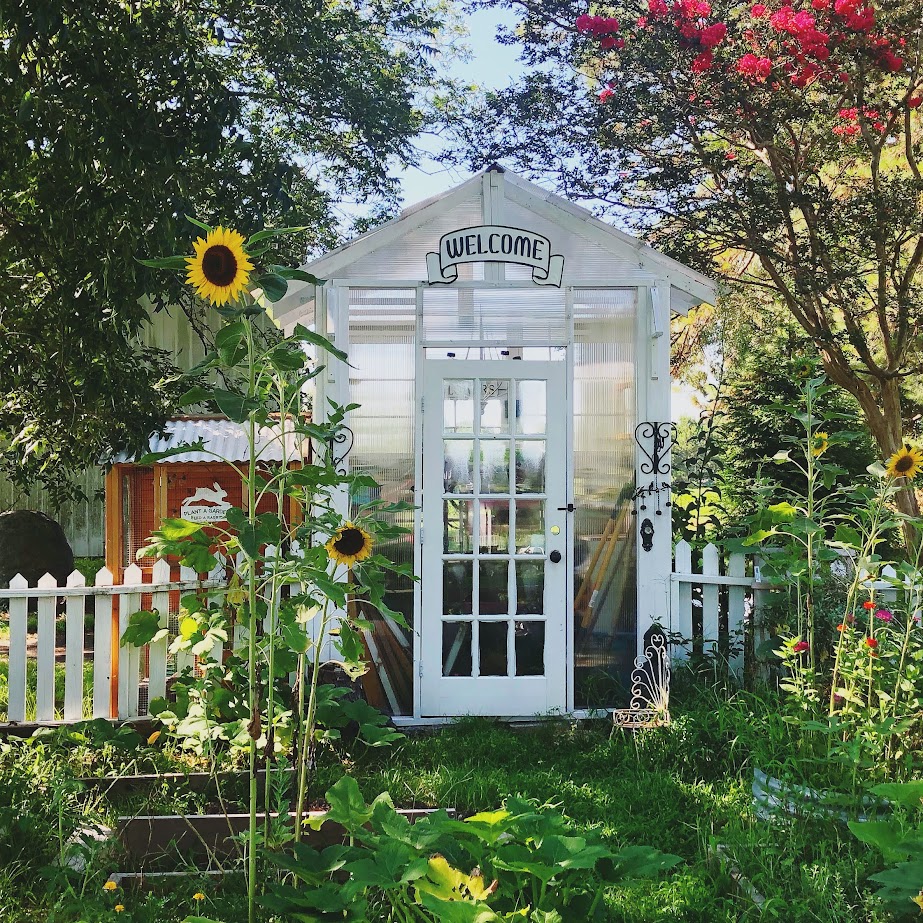
The Cottage Garden Greenhouse
Consider adding a quaint greenhouse to your garden if you have the space and means. This will extend your gardening season and allow you to nurture delicate plants and seedlings carefully.
We built our little greenhouse with 2x4s and reclaimed windows. It has added so much character to our dream garden!
Read more about how we did it here!
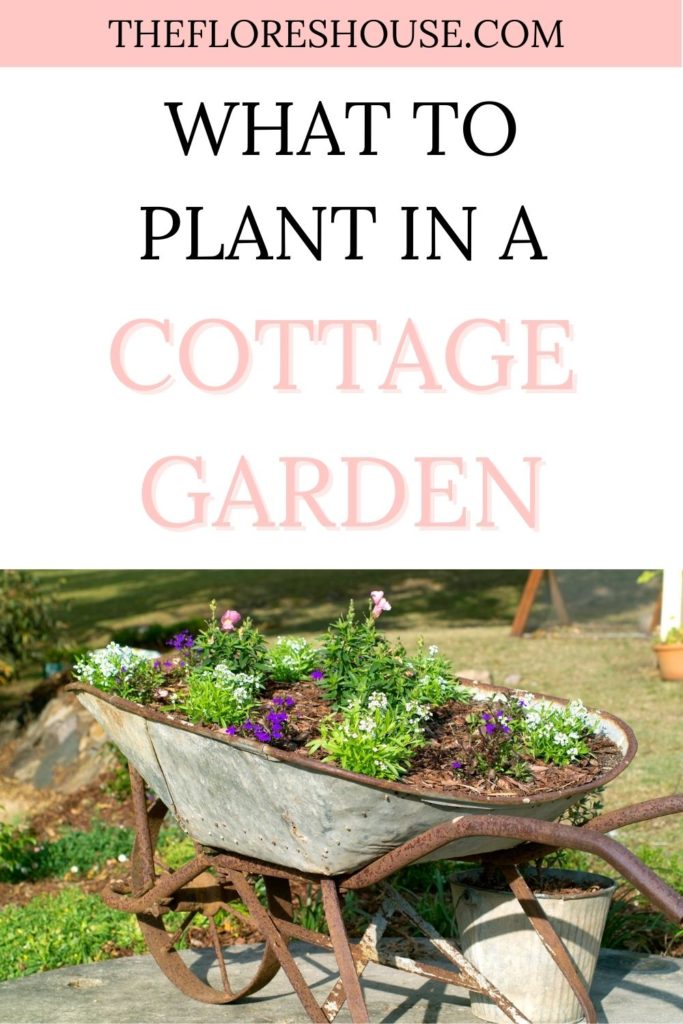
English Garden Care: Nurturing Your Cottage Paradise
Once your cottage garden is in full bloom, it’s essential to maintain its beauty. English garden care involves a delicate balance of nurturing and letting nature take its course.
Regular deadheading, weeding, and occasional pruning will keep your garden flourishing throughout the seasons.
Remember, a cottage garden reflects your personality and creativity, so let your imagination run wild and have fun!
Read Next: Heirloom Gardening for Homesteaders
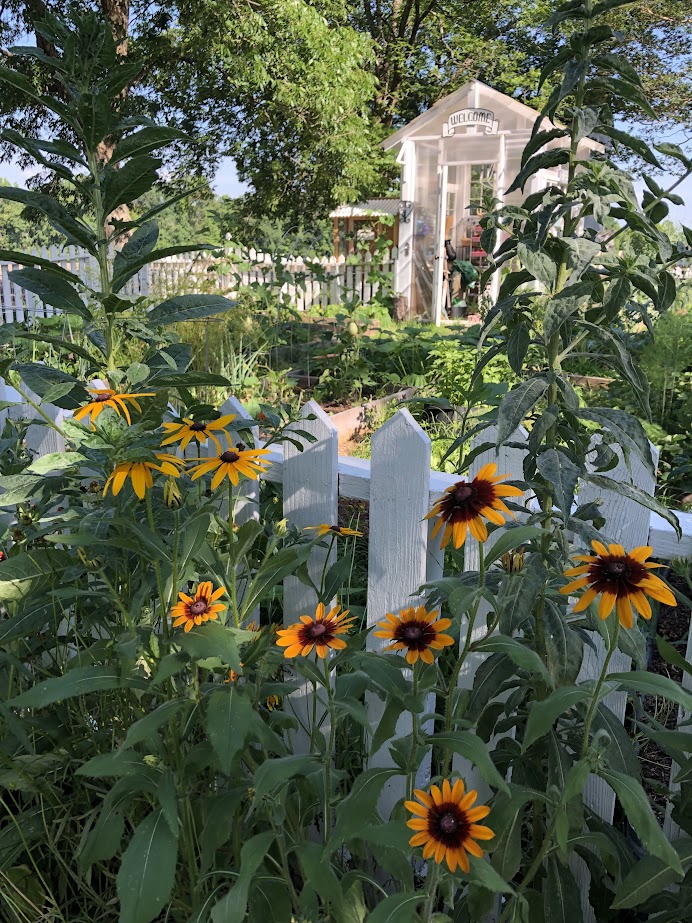
The Cottage Garden Haven of Gorgeous Plants
As you stroll along the charming paths of your cottage garden, surrounded by blossoming flowers and the gentle rustle of leaves, you’ll be transported to a haven of tranquility and wonder.
The magic of a cottage garden lies in its ability to whisk you away from the hustle and bustle of modern life and into a world of timeless beauty and nostalgia.
So, whether you’re an aspiring cottage farmer or a seasoned green thumb, take inspiration from the romantic allure of English and French cottage gardens, infuse a bit of modern flair, and create a space that feels like home.
With the right plants, design ideas, and a sprinkle of cottage-core charm, you’ll watch your garden bloom into a masterpiece that captures hearts and delights the senses for years.
